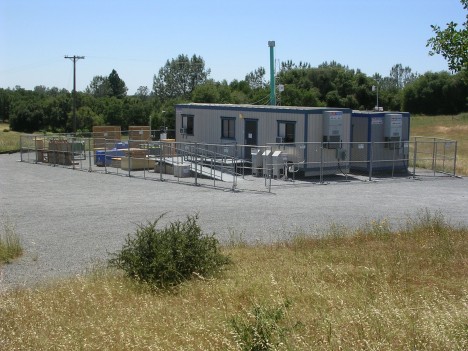

As previously stated, it is Cool like in Cool, CA.
Our first science meeting took place midway between T0 (McClellan Air Force Base) and T1 (Cool), so I couldn’t get a better chance to drive to the site that marks our downwind sampling location (T1, that is).
Off Rt. 80, you’ve got to follow the bends of 49 and down the gorge past Auburn, a real pretty town draped around the turns of historic Rt. 40. Then you drive up for another 4 miles past the Cool quarry.

Amidst this rural, very rural area, lies Northside Elementary school. Classes have been over for a week now, yet the backyard still hosts activity spurred by eternal kids with grey hair.
[youtube EX5qIuVhGWs 468]
This very repetitive bird emanates sound waves and the wind and
temperature in the atmosphere above are derived from their influence
on the speed of sound.
In trailers parked as control stations for ground instrumentation they are monitoring every spike in incoming particulates. Everything is very peaceful…trees, Sun, and even digital birds chirping.


Rushing back to the meeting, I found a room plenty with people anxious to display their first week of data. It is very important in the beginning of a campaign to make sure we establish a consistent baseline among all the different instruments.
Big discussions have already been engaged as to what pertains to local events as opposed to consistent transport patterns, but some points confirm the expectations. On a daily basis, a wide variety of small particles including black carbon get transported until they’re detected miles downwind from the sources, growing in size and getting coated with sulfates and other organics. More mysteries are hidden behind the unexpected amount of ultrafine particles, less than 10 nanometers in size (1 nanometer is a billionth of a meter). We’re not sure where they come from but they’re all around the urban areas.
Matteo